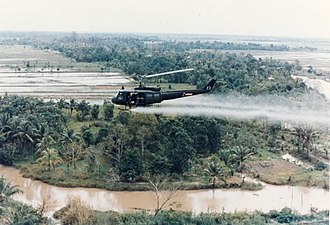
Back العامل البرتقالي Arabic Агент «Оранж» Byelorussian Агент Ориндж Bulgarian Agent Orange Breton Agent taronja Catalan Agent Orange Czech Agent Orange Danish Agent Orange German Πορτοκαλί παράγοντας Greek Agent Orange Esperanto
| Part of a series on |
| Pollution |
|---|
 |
Agent Orange is a chemical herbicide and defoliant, one of the tactical use Rainbow Herbicides.
It was used by the U.S. military as part of its herbicidal warfare program, Operation Ranch Hand,[1] during the Vietnam War from 1961 to 1971.[2] It is a mixture of equal parts of two herbicides, 2,4,5-T and 2,4-D. In addition to its damaging environmental effects, traces of dioxin (mainly TCDD, the most toxic of its type)[3] found in the mixture have caused major health problems for many individuals who were exposed, and their children.
Agent Orange was produced in the United States from the late 1940s and was used in industrial agriculture, and was also sprayed along railroads and power lines to control undergrowth in forests. During the Vietnam War, the U.S. military procured over 20,000,000 U.S. gal (76,000,000 L; 17,000,000 imp gal), consisting of a fifty-fifty mixture of 2,4-D and dioxin-contaminated 2,4,5-T. Nine chemical companies produced it: Dow Chemical Company, Monsanto Company, Diamond Shamrock Corporation, Hercules Inc., Thompson Hayward Chemical Co., United States Rubber Company (Uniroyal), Thompson Chemical Co., Hoffman-Taff Chemicals, Inc., and Agriselect.[4]
The government of Vietnam says that up to four million people in Vietnam were exposed to the defoliant, and as many as three million people have suffered illness because of Agent Orange,[5] while the Vietnamese Red Cross estimates that up to one million people were disabled or have health problems as a result of exposure to Agent Orange.[6] The United States government has described these figures as unreliable,[7] while documenting cases of leukemia, Hodgkin's lymphoma, and various kinds of cancer in exposed U.S. military veterans. An epidemiological study done by the Centers for Disease Control and Prevention showed that there was an increase in the rate of birth defects of the children of military personnel as a result of Agent Orange.[8][9] Agent Orange has also caused enormous environmental damage in Vietnam. Over 3,100,000 ha (7,700,000 acres) or 31,000 km2 (12,000 sq mi) of forest were defoliated. Defoliants eroded tree cover and seedling forest stock, making reforestation difficult in numerous areas. Animal species diversity is sharply reduced in contrast with unsprayed areas.[10][11] The environmental destruction caused by this defoliation has been described by Swedish Prime Minister Olof Palme, lawyers, historians and other academics as an ecocide.[12][13][14][15][16]
The use of Agent Orange in Vietnam resulted in numerous legal actions. The United Nations ratified United Nations General Assembly Resolution 31/72 and the Environmental Modification Convention. Lawsuits filed on behalf of both U.S. and Vietnamese veterans sought compensation for damages.
Agent Orange was first used by the British Armed Forces in Malaya during the Malayan Emergency. It was also used by the U.S. military in Laos and Cambodia during the Vietnam War because forests near the border with Vietnam were used by the Viet Cong.
- ^ Buckingham 1982.
- ^ "Agent Orange Linked To Skin Cancer Risk". Science 2.0. January 29, 2014. Archived from the original on October 23, 2019. Retrieved February 1, 2020.
- ^ "Agent Orange and Cancer". American Cancer Society. February 11, 2019. Archived from the original on December 1, 2019.
- ^ "Manufacturing Sites". Agentorangerecord.com. December 28, 2010. Archived from the original on February 5, 2022. Retrieved February 11, 2022.
- ^ Stocking B (June 14, 2007). "Agent Orange Still Haunts Vietnam, US". The Washington Post. ISSN 0190-8286. Archived from the original on March 30, 2017. Retrieved March 29, 2017.
- ^ King J (August 10, 2012). "U.S. in first effort to clean up Agent Orange in Vietnam". CNN. Archived from the original on March 3, 2013. Retrieved August 11, 2012.
- ^ Tucker SC, ed. (2011). "Defoliation". The Encyclopedia of the Vietnam War : a Political, Social, and Military History (2nd ed.). ABC-CLIO. ISBN 978-1-85109-961-0.
- ^ Raloff J (1984). "Agent Orange and Birth Defects Risk". Science News. 126 (8): 117. doi:10.2307/3969152. JSTOR 3969152.
- ^ "Agent Orange". Anzac Portal. Archived from the original on July 30, 2021. Retrieved July 30, 2021.
- ^ Cite error: The named reference
Vallerowas invoked but never defined (see the help page). - ^ Furukawa 2004, p. 215.
- ^ Zierler D (2011). The invention of ecocide: agent orange, Vietnam, and the scientists who changed the way we think about the environment. Athens, Ga.: Univ. of Georgia Press. ISBN 978-0-8203-3827-9.
- ^ "How Imperative Is It To Consider Ecocide As An International Crime?". IJLLR. December 18, 2022. Retrieved June 21, 2023.
- ^ Falk RA (1973). "Environmental Warfare and Ecocide — Facts, Appraisal, and Proposals". Bulletin of Peace Proposals. 4 (1): 80–96. doi:10.1177/096701067300400105. ISSN 0007-5035. JSTOR 44480206. S2CID 144885326.
- ^ "Industrial disasters from Bhopal to present day: why the proposal to make 'ecocide' an international offence is persuasive – The Leaflet". theleaflet.in. February 17, 2022. Retrieved June 21, 2023.
- ^ Giovanni C (April 1, 2022). "Ecocide: From the Vietnam War to International Criminal Jurisdiction? Procedural Issues In-Between Environmental Science, Climate Change, and Law". SSRN 4072727.